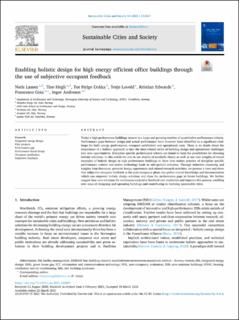| dc.contributor.author | Lassen, Niels | |
| dc.contributor.author | Hegli, Tine | |
| dc.contributor.author | Dokka, Tor Helge | |
| dc.contributor.author | Løvold, Terje | |
| dc.contributor.author | Edwards, Kristian | |
| dc.contributor.author | Goia, Francesco | |
| dc.contributor.author | Andresen, Inger | |
| dc.date.accessioned | 2021-04-06T14:29:25Z | |
| dc.date.available | 2021-04-06T14:29:25Z | |
| dc.date.created | 2021-04-01T08:50:12Z | |
| dc.date.issued | 2021 | |
| dc.identifier.citation | Sustainable cities and society. 2021, 69 . | en_US |
| dc.identifier.issn | 2210-6707 | |
| dc.identifier.uri | https://hdl.handle.net/11250/2736443 | |
| dc.description.abstract | Today’s high-performance buildings answer to a large and growing number of quantitative performance criteria. Performance gaps between design and actual performance have however been identified as a significant challenge for both energy performance, occupant satisfaction and operational costs. There is no doubt about the importance of a holistic approach to turn the inter-related series of building design and operational challenges into new opportunities. Discipline specific performance criteria are found to limit the possibilities for choosing holistic solutions. In this article we aim to use studies of available theory as well as our own insights of recent examples of holistic design in high-performance buildings to show how todays practice of discipline specific performance criteria and active technology leads to sub-optimal solutions. Through inductive reasoning and insights from literature, personal design experiences and related research activities, we present a view and show that subjective occupant feedback in the post-occupancy phase can gather crucial knowledge and documentation which can empower holistic design solutions and close the performance gaps in future buildings. We further suggest how new solutions for continuous subjective feedback can modernize and improve this process, enabling new ways of designing and operating buildings and contributing to realizing sustainable cities. | en_US |
| dc.language.iso | eng | en_US |
| dc.publisher | Elsevier | en_US |
| dc.rights | Navngivelse 4.0 Internasjonal | * |
| dc.rights.uri | http://creativecommons.org/licenses/by/4.0/deed.no | * |
| dc.title | Enabling holistic design for high energy efficient office buildings through the use of subjective occupant feedback | en_US |
| dc.type | Peer reviewed | en_US |
| dc.type | Journal article | en_US |
| dc.description.version | publishedVersion | en_US |
| dc.source.pagenumber | 13 | en_US |
| dc.source.volume | 69 | en_US |
| dc.source.journal | Sustainable cities and society | en_US |
| dc.identifier.doi | 10.1016/j.scs.2021.102867 | |
| dc.identifier.cristin | 1901897 | |
| dc.relation.project | Norges forskningsråd: 277048 | en_US |
| dc.description.localcode | © 2021 The Author(s). Published by Elsevier Ltd. This is an open access article under the CC BY license (http://creativecommons.org/licenses/by/4.0/). | en_US |
| cristin.ispublished | true | |
| cristin.fulltext | original | |
| cristin.qualitycode | 1 | |

